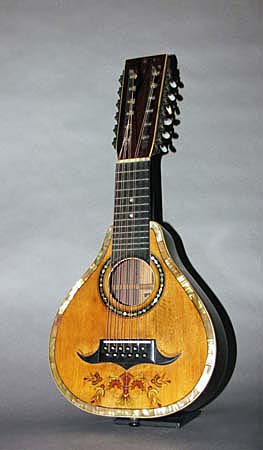
Owner: HWMC
Catalog#: 2CL-CHLT-111
Lutes (Guitar)
Spain ‘Bandurria’ (Guitar/Cittern)
Spain
Spanish
Rosewood back and sides, Brazilian cedar neck, spruce top, mother-of-pearl inlay, metal strings
Early 20th century
Length: 26 inches
Chordophones – Lutes
The bandurria (mandurria), is a small, flat back fretted lute (similar to the guitar and cittern) originally from Spain and can also be found in part of Latin America, including Cuba, Guatemala, Peru, Columbia and Chile. In Spain it is played with a pua (plectrum) and is used to play the melody part of the rondallas, tunas, or orquestas de pua string ensembles. Today it is used in many styles of folk and popular music. In the Balearic Islands of the Mediterranean Sea, it is known as the mandurria. This bandurria is known as the Lakeside model and was made by Lyon & Healy of Chicago, Ill, dating from approximately 1900 to the mid-1920s.
This Lakeside model bandurria has a pear-shaped acoustic body with deep ribs, a flat back, and a fingerboard with 12 metal frets. There are 12 metal strings – 6 courses that are strung to guitar-type machine tuners at the top, and pass over a circular soundhole adorned with mother-of-pearl inlay to a flat bridge that is affixed to a metal tailpiece on the soundboard. The edges of this bandurria are adorned with a wide strip of mother-of-pearl inlay and there is a beautiful gold and red leaf pattern painted below the tailpiece. The bandurria is tuned g# – c#’ – f#’ – b’ – e’’- a’’ (beginning with the G# below middle C).
Resource: “Bandurria,” John M. Schechter/Mauricio Molina. “The Grove Dictionary of Musical Instruments.” 2nd ed., Vol. 1., Laurence Libin, Editor in Chief. Oxford University Press, 2014.
